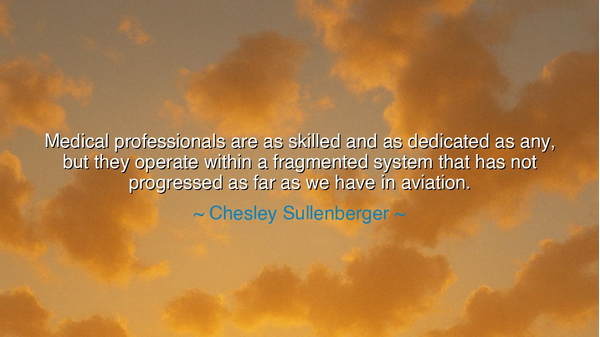
Medical professionals are as skilled and as dedicated as any, but
Medical professionals are as skilled and as dedicated as any, but they operate within a fragmented system that has not progressed as far as we have in aviation.






Hear the words of Chesley Sullenberger, the captain who guided a wounded plane to safety upon the waters of the Hudson: “Medical professionals are as skilled and as dedicated as any, but they operate within a fragmented system that has not progressed as far as we have in aviation.” In this reflection lies a comparison drawn from his own life’s work. He honors the devotion and excellence of doctors, nurses, and healers, yet laments that the structure surrounding them lags behind, failing to match their brilliance with unity, coordination, and discipline.
The origin of this thought rests in Sullenberger’s world of aviation. In the skies, every pilot is guided not only by skill but by a system forged in fire and tragedy. Checklists, training, communication protocols—all are woven together into a fabric of safety. Errors are studied, lessons are shared, and improvements are adopted across the entire industry. It is this structure that allowed Sullenberger, on that fateful day, to bring down his crippled craft without loss of life. He contrasts this with medicine, where despite the dedication of its practitioners, systems remain fractured, inconsistent, and too often resistant to change.
The ancients knew that even the strongest warrior is powerless without the phalanx, without order in the ranks and trust in the shield beside him. Medicine, like war or flight, demands not only individual mastery but collective strength. Yet, as Sullenberger notes, in healthcare the phalanx is broken—hospitals may fail to speak to one another, records are scattered, and errors are repeated rather than shared. Thus, the healer’s sword grows dull not from lack of skill but from the absence of a system that binds and supports.
Consider the story of the Institute of Medicine’s report “To Err Is Human” in the year 1999. It revealed that tens of thousands die each year in the United States not from lack of medical knowledge, but from preventable errors—mistaken medications, poor communication, failures in coordination. In aviation, such failures would trigger sweeping reform; in medicine, they often linger. This is the very truth Sullenberger names: that the brilliance of individuals is blunted by the weakness of systems.
The meaning of his words is both praise and rebuke. He exalts the medical professionals, for their skill rivals that of any pilot, any engineer, any soldier. Yet he laments that they are trapped within a labyrinth not of their making, where silos and fragmentation hinder progress. His call is not to question the devotion of the healer, but to awaken society to the need for reform, to build in medicine the same culture of safety and continuous improvement that lifted aviation from its own bloody past into the modern age of reliability.
The lesson for us is clear: brilliance alone is not enough. Even the most skilled healer, like the most skilled pilot, needs a system that supports, guides, and safeguards. It is not enough to rely upon the heroism of individuals; we must build structures that ensure safety and learning for all. To honor the sacrifices of medical professionals, we must give them not only respect but also the tools, systems, and culture that allow their gifts to flourish without being undermined.
Practical action follows. Support reforms that unify medical records, encourage transparency, and prioritize patient safety. Demand systems where errors are studied and shared, not hidden. Learn from industries like aviation, where humility before error has become the foundation of safety. And as individuals, trust not only in the doctor’s skill but in the systems we help to shape through advocacy, awareness, and accountability.
Thus Sullenberger’s words become a teaching for generations. He reminds us that the healer’s heart burns as brightly as the pilot’s courage, but without a system to channel their strength, even the greatest cannot save all lives. Let us, then, build in medicine what has been built in aviation: a structure of unity, humility, and continuous learning. For in that lies not only the safety of patients, but the fulfillment of the healer’s noble calling.






AAdministratorAdministrator
Welcome, honored guests. Please leave a comment, we will respond soon